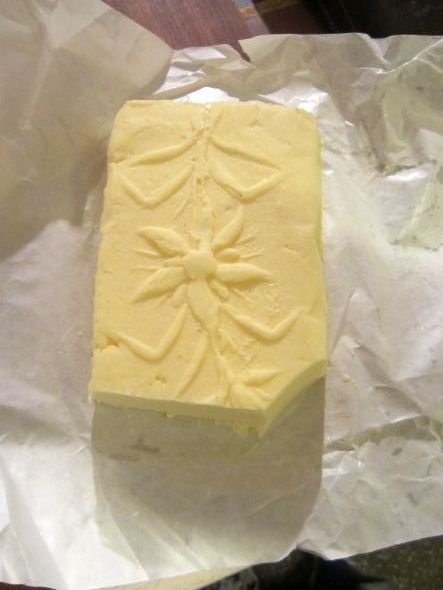While everyone else is carbo-loading with frittelle and galani, Lino has taken our modest domestic feedbin in another direction: the classic-Venetian-fish-dishes direction. If you stay on that road, it won’t be long before you find yourself in the suburbs of heaven.
These specialties have no relation to Carnival — it’s mere happenstance that we’ve eaten them now, in the interval in which everything is famously permitted, including frying in lard. (Not made up; our butcher at the Rialto was selling plastic bags of white, waxy-looking rendered pig fat which makes pastry the food of the freaking gods).
Let’s proceed in non-alphabetical order. First, the schie.
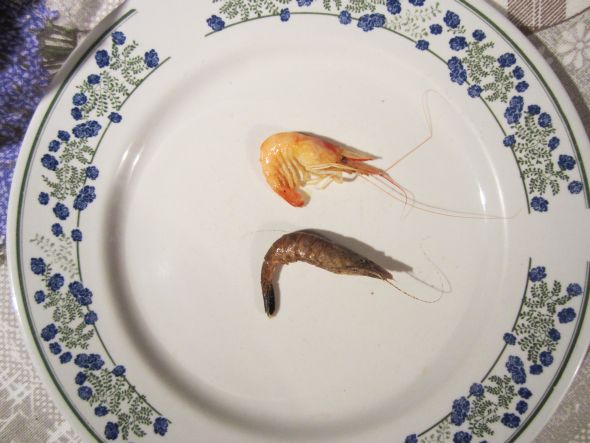
Schie (SKEE-eh) (Crangon crangon) are a variety of tiny gray shrimp found in the lagoon and elsewhere. They were once a reliable standby of people who were tending toward poor, such as lagoon fishermen, or large families on small budgets, which is redundant.
Lately, though, its distant relations, or even impostors, have begun to show up in restaurants and bars.
A noticeable number of trattorias, keen to entice tourists with traditional dishes, have begun to offer what they call polenta with schie. They correctly promote it as a great Venetian specialty, and if you mention this combination to older Venetians, at least some will respond with an appreciative “Ie, ie, ie, polenta co le schie” (EE-yeh, EE-yeh, poenta co eh skee-eh). This is the kind of phrase that they must have found entertaining when they were children. It’s a tasty combination, and filling, and cheap, or at least it was once. The perfect makings of a classic.
Now that the price of schie can go up to 40 euros per kilo at the Rialto market ($27 per pound), regular people — like us — don’t buy it anymore, and tourists eating out aren’t likely to know that what purports to be polenta and schie is only an approximation of the aforementioned dish.

Nowadays what the cook usually presents as polenta is infant’s gruel, a wide soft expanse of a golden substance I think of as Cream of Polenta. Real Venetian polenta (always yellow, never white — white is what they eat in the islands, or Pellestrina, or Chioggia, or Cape Town or Vladivostok) is firm, almost solid, and is to be eaten in slabs. Or at least in hefty chunks.
As for the schie, the little shrimpy morsels strewn atop the yellow mush in the restaurants are virtually always pink shrimp, perhaps from far away, who almost certainly have broken their journey in a freezer somewhere.
But the other day, on our way home, we passed Nardo, the local fisherman, and he offered us a half-kilo bag of schie for a paltry 10 euros ($13). Lino pounced. And cooked. And then we ate.
Here is the old Venetian way of cooking (and eating) these critters, as performed by Lino, who alone, pretty much, of all his race still has the patience and desire to put in the time and effort to prepare them. Note: The time involved in preparing schie isn’t noticeably great, but the other recipes require practically a solemn vow that you’ll persevere to the end.
SCHIE:
Rinse them.
Put them in a saucepan, fill with cold water, and some salt.
Bring to a boil.
Meanwhile, take something made of metal — we sacrificed an old stainless steel dinner knife — and pass it through the gas flame till it’s red-hot.
When foam covers the surface of the water in the pan, turn off the gas (fire, heat) and plunge the redhot knife into the schie-laden water and swirl it around. I have yet to discover the reason for this, but just do it. It will make you feel like Siegfried wielding the Wotan sword.
Pour the cooked schie into the pasta colander to drain off the boiling water.
In a bowl, pour some extravirgin olive oil, lots of sliced garlic, some pepper, and a tiny bit of salt.
Put the drained schie in the bowl with the oil and garlic, mix thoroughly, and eat.
Aha: Eating them. You can’t be in a hurry. If you have to catch a train, forget eating schie because you have to shell every dratted little one, one by one, and it’s nothing like shelling big brawny Atlantic prawns. It’s like picking bits of white mohair fluff off your navy-blue wool peacoat. Lino seems to regard it more as entertainment than nourishment. I regard it as just another great excuse to eat oil and garlic.
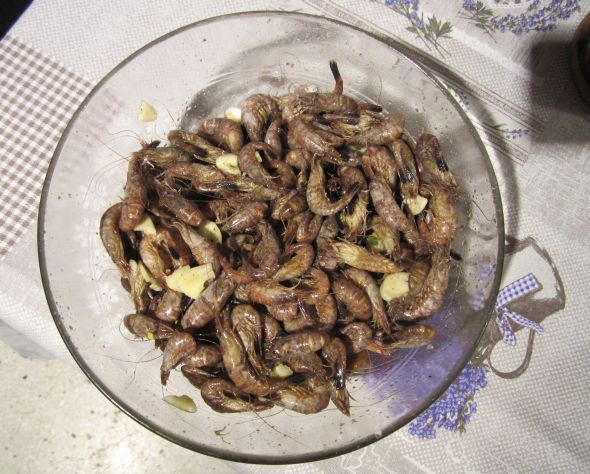
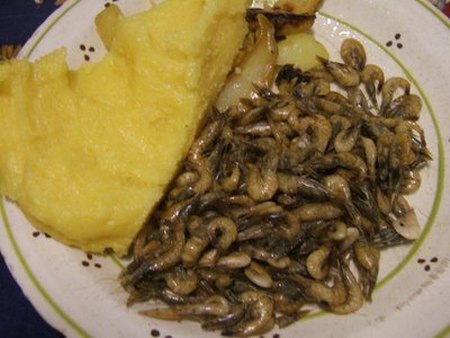
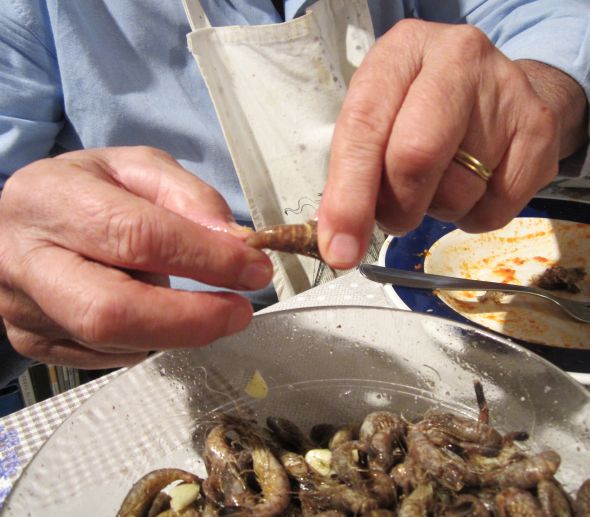
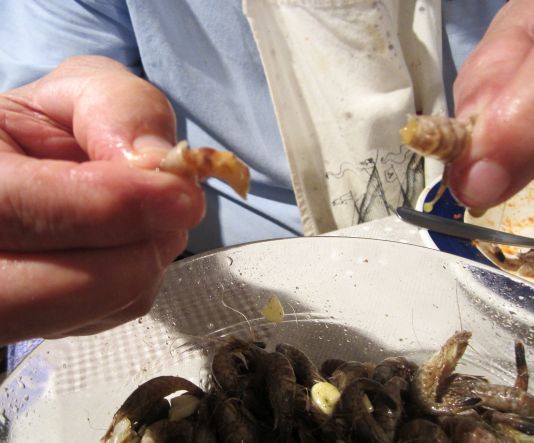

GRANSEOLA:
The European spider crab (Maja squinado) is a regular at tables in better restaurants, mainly as a toothsome antipasto, for a fairly toothsome price. Up the street, one menu offers this delicacy for 18 euros ($25) per person.
I like crab well enough, though I can’t say that my wildest dreams are dominated by crustaceans of the class Malacostrara. Then again, I’d never turn one down.
When we discovered some bouncing bonny crabs at the Rialto for 4 euros per kilo ($2.50 per pound), it seemed ridiculous to forego a few — even more ridiculous than paying 18 euros to eat one. Especially as Lino, as noted above, regards dismantling dwellers of the abyss as one of the few genuinely amusing activities around.
It takes about an hour to tease all the edible bits out of this animal; I think it’s something like meditation for him. We’ve never gotten around to acquiring fancy tools for this work. He uses a small screwdriver. I use a pocket-size dental pick. We sit there at the table together, surrounded by chips and splinters of crabshell, peering through glasses on noses, going pickpick scrapescrape and discussing subjects more disjointed than our little spiny victims.
We divided the spoils into two parts. We ate one half of the pulp arranged artfully in its shell just as they do in the restaurants, with a little pepper, olive oil and lemon.
The other half was transformed into an exceptional pasta sauce, composed of some saute’d onion, one tiny chili pepper, some tomato sauce, and half a glass of white wine.
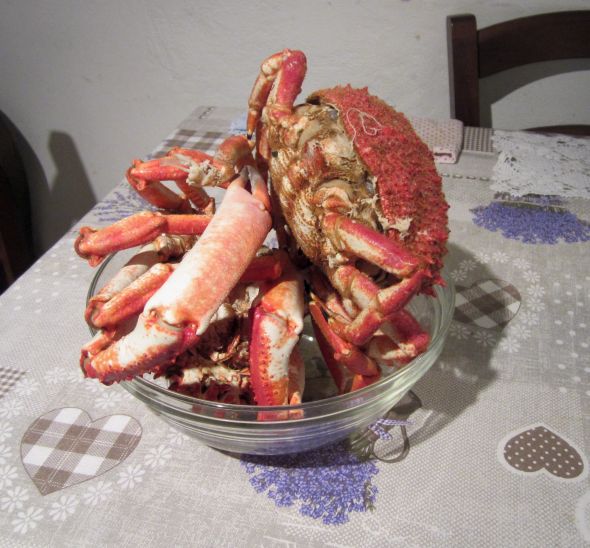
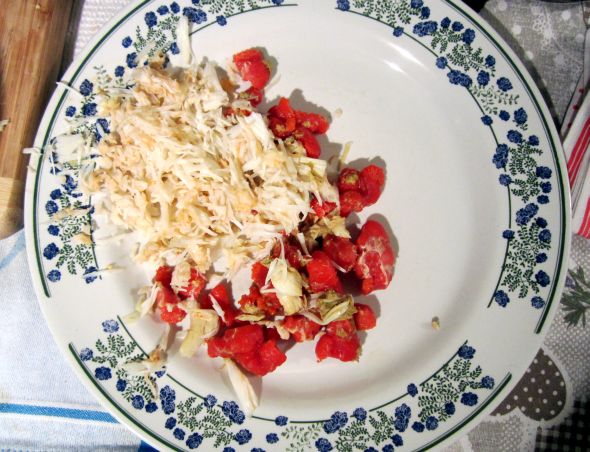
FRITTELLE DI BACCALA‘:
I have never seen this on any restaurant menu but it is often sold in bars as bacala’ impana’, or breaded fried baccala’. In the old days this substantial snack used to be baccala’, but considering that as the price and effort involved in preparing baccala’ is inversely proportional to the number of customers who would know what breaded baccala’ actually tastes like, the fish is often something else. Plaice is a common substitute. Hey: It’s white, it’s fish, it’s fried — what’s not to like? Nothing, unless you’re the type of person — such as your correspondent — who is also irked by men who row sandolos and offer their services by calling out “Gondola gondola,” or selling botoli and calling them castraure.
How would you know if it’s baccala’? Well, because the odds are almost 100% that it won’t be. But for the record, my experience is that the giveaway isn’t the taste, because by the time it reaches the being-fried stage, the sharpest edges of its particular flavor have been worn away, as explained below.
But you can’t fake the texture. Plaice is tender and ingratiating, a mere whiff of white fish flesh. Baccala’, no matter how much you may soak or boil it, will always retain its sturdy Arctic character: chewy, slightly resistent, giving your teeth a little work to do, even though you will swallow it knowing you couldn’t completely soften it before sending it to its fate. It’s like certain cuts of inexpensive meat: You just decide when you’ve chewed enough and down it goes.
To make any dish involving baccala’, you start with a dried, shrink-wrapped carcass. You can buy it already soaked and ready to cook, but it costs more, obviously.
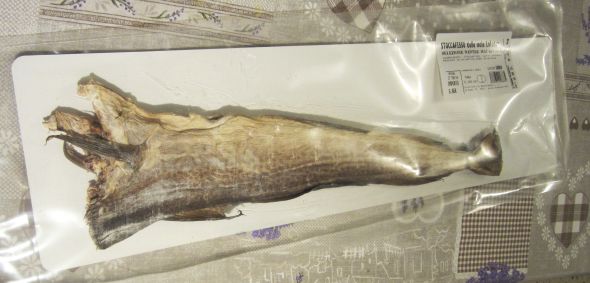
I warn you that baccala’ soaking emits an alarming smell. You may be appalled, which is understandable the first time. I just don’t want you to be surprised. You can cover the pan and put it in the oven, as we do, or otherwise enclose and conceal it. Don’t worry that the fish you finally eat will smell like that; when you pour off the water, the odor disappears.
- HOW TO PREPARE A DRIED BACCALA’ FOR COOKING:
Ingredients: Baccala’, water, salt, a capacious pan, and at least three days.
Put baccala’ in capacious pan, cover with water.
Change water every 6 hours for 3 days.
Day #3:
Change water. add a little salt, and bring to a boil. Boil for 40 minutes.
Remove from water and set it out to cool.
When it reaches room temperature, cut it open like a book.
Remove all the bones and the skin, pull off the pulp into pieces however they come off.
HOW TO PREPARE THE FRITTELLE:
Batter:
Put flour in bowl.
Place 10 grams of yeast in a glass with tepid water, mix gently.
Pour the water with yeast into the flour, mix.
Add some salt and pepper.
Form frittelle:
Put the pieces of baccala in the batter.
Cover with dishtowel and leave in a tepid environment for one hour.
Fry:
Pour enough olive oil in pan for deep frying.
Heat the oil– take a toothpick and put it in the oil, and if tiny bubbles form around it, the oil is ready.
With a spoon, remove pieces of baccala from the batter (however they come; they don’t have to come out one by one).
Put in hot oil, fry till golden.
Place on paper towels to drain.
Best eaten hot, but they’re not bad the next day if you leave them out at room temperature.
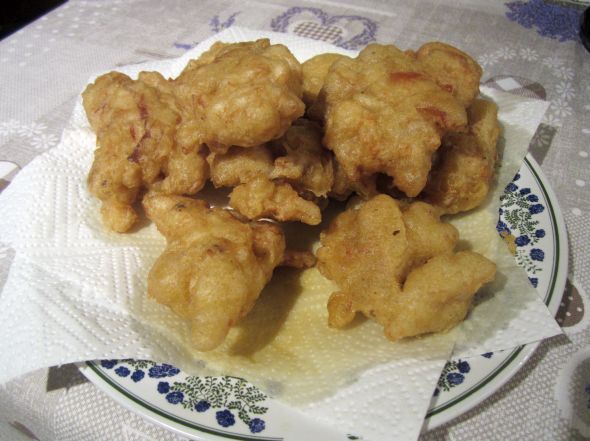
If you have been farseeing and clever, you will have put aside at least some of that soaked baccala’ pulp, so now you can make another gastronomic wonder known in Venetian as bacala’ in tecia (bahk-ah-LA in TEH-cha). A tecia is a saucepan (“pentola” in Italian).
And if, for some reason, you didn’t see fit to make polenta to eat with the schie, this would be an excellent moment to stir up a cauldron. There is an instant version, but please don’t tell Lino if you decide to use it. He makes the time-honored version that requires 40 minutes of frequent stirring.
BACALA’ IN TECIA:
Take 3 sardines that have been kept in salt, rinse and bone them.
Take 10 capers that have been kept in salt, rinse.
Take the pieces of fish, in whatever size or form they may be.
In saucepan, saute’ some chopped onions in extravirgin olive oil.
Add the baccala’ to the oil and onions.
Add the boned, rinsed sardines.
Add the rinsed capers.
Add tomato sauce and water.
Slowly simmer till done. If necessary, add more water to continue simmering.
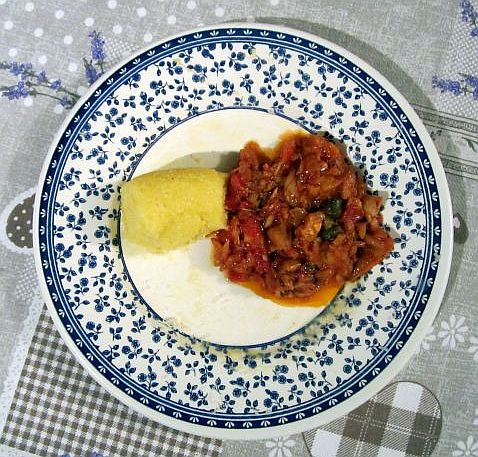
BONUS DELICACY:

